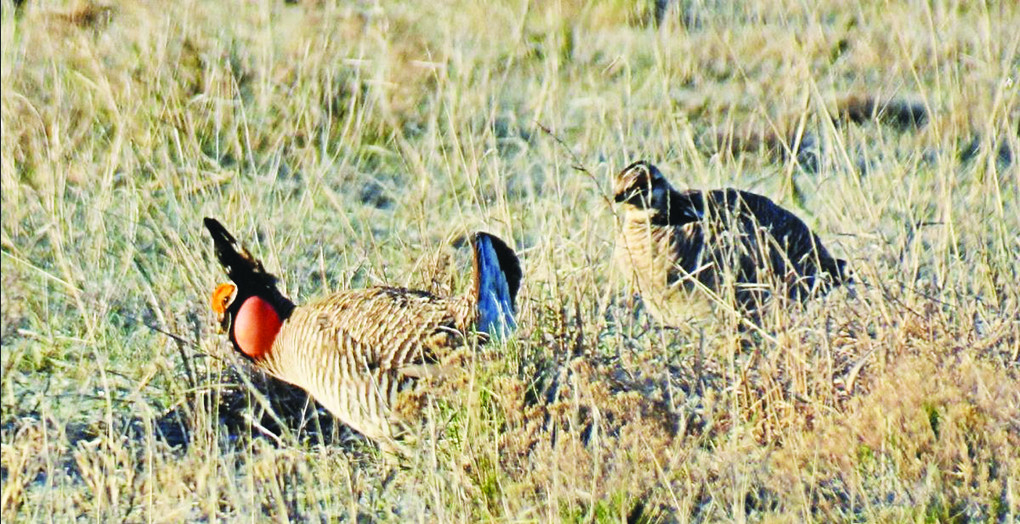Lesser Prairie Chicken leks produce hundreds of chickens

COLORADO – Lesser prairie chickens, gone for decades from the Colorado landscape, are again living on the eastern plains, thanks to an ambitious four-year project led by biologists from Colorado Parks and Wildlife, Kansas, the U.S. Forest Service, along with private landowners.
Recently completed surveys by CPW biologists revealed that hundreds of the birds are now thriving on breeding grounds, known as leks, on the plains extending across southeastern Colorado and western Kansas.
Lesser prairie chickens once numbered in the tens of thousands in those grasslands. But a variety of factors led to their gradual disappearance. Experts blame, in part, the conversion a century ago of grasslands to cropland that contributed to the Dust Bowl in 1932 and wiped out many of the birds. More recently, the lesser prairie chicken population in Southeast Colorado and Southwest Kansas was devastated by severe snowstorms, particularly in December 2006, followed by years of drought.
They even vanished on a 330,000-acre swath of sand sagebrush and grasslands known as the Comanche National Grassland in Baca County, Colorado, and the Cimarron National Grassland in Morton County, Kansas, as well as privately owned rangeland and Conservation Reserve Program grassland.
Because the Comanche and Cimarron grasslands are owned and managed by the U.S. Forest Service, biologists knew they could be easily used as a place to re-establish populations.
By 2016, biologists counted just two males on the Comanche Grasslands and five males on the Cimarron.
That same year, CPW decided to try relocating lesser prairie chickens from thriving breeding grounds in Kansas in hopes of resurrecting leks on the national grasslands. So a CPW team, led by conservation biologists Jonathan Reitz and Liza Rossi, began working in collaboration with the Kansas Department of Wildlife, Parks and Tourism, Kansas State University and the U.S. Forest Service.
“This partnership demonstrates what collaborative management efforts can do to restore a species to an area,” Rossi said. “However, agencies working together is just one component of the project. Landowner support and access to private lands were absolutely critical for capture of birds and continue to be essential for long-term monitoring at the release sites. Recovery of this amazing species will take all of us working together.”
Over the past four years, the team of Colorado and Kansas biologists, and K-State graduate students, relocated 103 males and 102 females to the Comanche Grasslands. The team also released 101 males and 105 females during the same time period just east of the state line in Kansas, making this the largest known translocation effort for lesser prairie-chickens.
“It was a huge challenge because lesser prairie-chickens don’t just stay where we release them,” Reitz said. “We had some chickens that we released and tracked as they flew great distances. We’ve observed some traveling 70 miles or more from the release site.”
Now, Colorado and Kansas biologists and technicians have found 20 active leks with lesser prairie chickens that are the offspring of transplants. The biologists counted at least 115 males, based on the spring surveys, Reitz said.
“The situation for lesser prairie chickens in our state had gotten pretty dire,” Reitz said. “I am excited by what we’re learning from our surveys and hopeful this will be a long-term solution.”
The CPW team knows exactly how far some travel because they attached monitoring devices to the chickens before their release. Most were equipped with transmitters that allow them to be tracked by radios using a special antenna. Others were fitted with solar powered, GPS backpacks that transmit the chickens’ location 10 times a day. CPW expects to monitor them for an additional year.
“We’ve documented many of the birds making their way down into Oklahoma and even the Texas panhandle,” Reitz said. “It’s not uncommon for them to take off upon release and travel great circles, for as much as 250 miles, before eventually returning to the release spot and settling down.”
And that leads into the current phase of this wildlife conservation effort. CPW and Kansas biologists will continue to count and search for newly established leks as well as track the birds with radio transmitters for as long as the batteries keep working.
“Our technicians are tracking them on the ground as the birds spread out,” Reitz said. “We use an airplane to find them and point our technicians in the right direction. We have now documented three years of successful nesting and brood rearing. This spring, most of the birds we are seeing on the new leks are offspring of our translocated birds. That’s been really encouraging to see this level of success for the project.”



